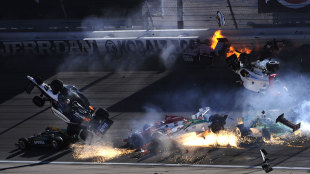

You would have to be living under a rock not to know that Thursday marked the twentieth anniversary of Ayrton Senna's untimely death, or about the four-day memorial taking place at Imola to honour the Brazilian and Roland Ratzenberger, who died on April 30, 1994.
The internet has been filled with tributes, from personal recollections from those who knew him best to comment pieces by those who weren't yet born during that black weekend in Imola.
One of the more interesting tributes at Imola was a series of talks on driver safety standards in the years since Senna's death, which included a speech read on behalf of FIA president Jean Todt - who was unable to attend - by Angelo Sticchi Damiani, FIA vice president for sport and president of the Automobile Club d'Italia.
Todt used the opportunity to reflect on the great strides in driver safety made in the past twenty years, and their impacts on both race cars and road cars. And while it was a largely positive speech, the Frenchman also made some negative - and very salient - points.
"It is with regret that I have to note that while Formula One has become a much safer environment, other forms of motorsport still see serious injury and fatalities every year, and once again this is proof that we must always be vigilant and that we must always seek to improve safety standards," Todt's speech read.
"It is greatly encouraging that many F1 technologies have been redeveloped in cost-effective form of use in other formulae, but more must be done, and the FIA - in collaboration with circuits, teams, drivers, and the wider motorsport industry - will continue to explore measures to replicate the kind of improvements seen in grand prix racing over the past twenty years in other forms of racing.
"… While the technologies developed for motorsport are often specific to the track environment, many developments have positive benefits for road safety. Safer helmets and restraint systems; crash barrier research; use of data recorders; passive safety and active telemetry: all are examples where cutting-edge motorsport safety research is making an important contribution in the global fight to save lives on the road."
Formula One has long been the standard-bearer for safety improvements in motorsport, but when participating in events organised on a club or national level I have seen basic safety breaches that were lucky not to result in death.
Several years ago, in an unnamed European country hosting a local rally covering three counties, I was looking for a vantage point from which to watch the cars when I was directed - by event officials - into a line of competitors' cars despite my protestations that I was merely a fan. Keeping pace with rally drivers en route to their first stage of the day was a thrilling experience, but hardly a safe one.
After breaking free from the line of competitors and parking my car in a nearby field, I found a great vantage point, at the top of a cliff above a fast left-hander. I was shocked to see fans standing on the inside of the corner, with not even a piece of safety tape to protect them from the cars that were passing so close some of the braver (more foolish…) fans smacking the roofs as they zipped past.
Sadly, that rally did lead to a fatality, with one of the local entrants losing their life.
Deaths in rally and road racing are all too common. But because the fatalities have often been at club and national level, the relative lack of exposure - the lack of an Imola moment - has meant that there has not been an F1-style response to improve safety standards. Complicating matters further are the impediments of road racing, which is a lot harder to safeguard than an event within the confines of a circuit, and the fact that club, local, and national events often lack the funding to invest in improved safety measures.
Which brings us neatly around to Todt, who is putting his (FIA) money where his mouth is when it comes to investing in grassroots motorsport and improving safety standards for drivers, officials, and spectators alike. The Motorsport Development Fund, administered by the FIA Institute, enables member clubs to apply for grants to help develop motorsport in their regions, while the September 2013 creation of the FIA Closed Road Commission acknowledged the challenges unique to closed-road racing.
The body is "responsible for examining safety measures on roads used for rallies, cross country rallies, hill climbs, acceleration events and any other speed competitions, [and is] charged with gathering data and making recommendations pertaining to the safety of a course, the measures in place to protect drivers, officials and spectators, as well as the procedures regarding organisation and supervision of these events."
